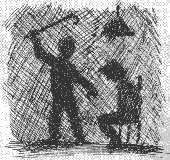URUGUAY:
HOW WE CRUSH NONVIOLENT PROTEST AGAINST A CORRUPT REGIME, USING THE SOA TO UNDERMINE OUR OWN LAWS

(1) The Uruguayan military institutes a totalitarian regime far beyond anything in Eastern Europe.
(2) This is done with full US support, including torture-training from the SOA.
The gory details …
During the 1960s, Uruguay is in the midst of a long-running economic decline under the watch of US corporations and a US-supported anti-democratic regime, with widespread poverty, labor strikes, student demonstrations, and militant street violence, and the largely nonviolent Tupamoros, "[p]erhaps the cleverest, most resourceful and most sophisticated urban guerrillas the world had ever seen," with widespread public support and secret admirers in key positions in the government, banks, universities, professions, military, and police.
"[T]he Tupamoros normally avoid bloodshed when possible. They try instead to create embarrassment for the Government and general disorder." — New York Times, 8/1/70 [E.g., publishing raided files of big private corporations to expose corruption and deceit, or publishing transcripts of trials in "People’s Court" of temporarily kidnapped corrupt public officials.]
The US-armed and US-trained military crush the Tupamoros in 1972, institute 11 years of repressive dictatorship, with "the largest number of political prisoners per capita in the world [about 60,000 people, roughly 2 percent of the population], … each one of them was tortured." — The Guardian (London) 10/19/84, Human Rights Quarterly, 5/82.
In the most extreme case, nine top Tupamoro leaders, following months of the most brutal physical torture, are kept in complete solitary confinement for over a decade. "In over eleven and a half years, I didn’t see the sun for more than eight hours altogether. I forgot colors—there were no colors." – Mauricio Rosencof, who spends his confinement at the bottom of a well.
Families are incorporated into the routine of torture and psychological abuse—children are sometimes permitted to visit their parents once a month, but only if the parent demonstrates no sign of affection.
The military seeks to penetrate and "purify" all aspects of Uruguayan life. Each school receives a new, "politically reliable" director, and each class is given a "teacher’s aide" to take notes on the behavior of students and teachers. A permit is required to hold a birthday party. Elections for captains of amateur soccer teams are supervised by the military, which can veto the results. A public performance of Ravel’s Piano Concerto for the Left Hand is banned because of its sinister title.
"People were in prison so that prices could be free."
— dissident Uruguayan writer Eduardo Galeano
The American torture-training role …
"The precise pain, in the precise place, in the precise amount, for the desired effect." — Dan Mitrione, head of the US "Office of Public Safety" in Montevideo, 1969-1970
"The violent methods [of "routine torture"] which were beginning to be employed [by "US advisers, and in particular Mitrione"] caused an escalation in Tupamaro activity. Before then their attitude showed that they would use violence only as a last resort." Alejandro Otero, Uruguayan Chief of Police Intelligence, CIA agent, demoted for his testimony
"One of the pieces of equipment that was found useful was a wire so very thin that it could be fitted into the mouth between the teeth and by pressing the gum increase the electrical charge. And it was through the diplomatic pouch that Mitrione got some of the equipment he needed for interrogations, including these fine wires." — New York Times’ A.J. Langguth, 1981 interview
Torture becomes a "normal, frequent and habitual occurrence" including "electric shocks to the genitals, electric needles under the fingernails, burning with cigarettes, the slow compression of the testicles, daily use of psychological torture", … "pregnant women were imprisoned with their very young infants and subjected to the same treatment" — unamimous conclusion of [Uruguayan] Senate Commission of Inquiry into Torture
"Between 1969 and 1973, at least thirteen Uruguayan police officers went through an eight-week course at CIA/OPS schools in Washington and Los Fresnos, Texas in the design, manufacture and employment of bombs and incendiary devices … there was no instruction in destroying bombs" — report based on US State Department documents obtained by Senator James Abourezk in 1973
"As subjects for the first testing they took beggars … from the outskirts of Montevideo, as well as a woman apparently from the frontier area with Brazil. There was no interrogation, only a demonstration of the effects of different voltages on the different parts of the human body…. The four of them died." — Manuel Hevia Cosculluela, former CIA agent and associate of Mitrione
Mitrione’s demise, and the role of the SOA …
Dan Mitrione was finally kidnapped in 1970 by the Tupamoros. They do not torture him. They demand the release of some 150 prisoners in exchange for him. With the determined backing of the Nixon administration, the Uruguayan government refuses. … Mitrione’s dead body is found on the back seat of a stolen car.
"Mr. Mitrione’s devoted service to the cause of peaceful progress in an orderly world will remain as an example for free men everywhere." — Ron Ziegler, White House spokesperson
Mitrione’s "Office of Public Safety" has trained over a million policemen in the Third World. Ten thousand receiving advanced training in the US. The OPS was finally abolished by Congress in the mid-70s. But within a year Drug Enforcement Administration agents are engaging in many of the same activities the OPS had been carrying out. — 1975 report of the General Accounting Office
A former Uruguayan intelligence officer declares that US manuals were being used to teach techniques of torture to his country’s military. He said that most of the officers who trained him had attended classes run by the United States in Panama [i.e., the School of the Americas]. Among other niceties, the manuals list 35 nerve points where electrodes can be applied. — San Francisco Chronicle, 11/2/81